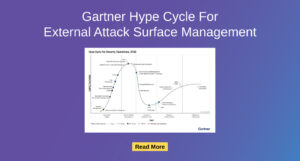What Is Attack Surface management (ASM)?
If you were to imagine a scenario where you have just been hacked, what are the fastest routes a cyber-attacker could use to reach your core infrastructure or information? The chances are, you don’t know.
Irrespective of how your network is designed, your actual connectivity and change of information might constantly change during workdays. For instance, there are internet exposed infrastructure, exposed database servers and cloud buckets, etc.
These shifts in connectivity, login credentials, and information storage are avenues through which Advanced Persistent Threat (APTs) and other stealth attackers use to reach their target systems of information. These avenues or routes are collectively referred to as attack surfaces. Thus, attack surface management is crucial for organizations to evade cybersecurity threats efficiently.
The more the connectivity and movement of information the more expansive the attack surface gets. Even for organizations with strong network security protocols, the window of opportunity is all it takes for cyber intruders to gain access to essential systems and information.
Attack Surface Management (ASM) and attack surface mapping provide perpetual discovery and selective automation required to quickly and extensively detect and eliminate risky routes.
(Quick Resource: Here are some common questions normally asked about Attack Surface Management)
What Is At Stake?
ASM Management is essential as a defense mechanism against cyber threats. The following are at risk without ASM:
The Rise In Shadow IT Assets And Risks – According to a survey conducted by Stratecast and Frost & Sullivan, 80% of employees say they use applications on the job that are not known by IT. Shadow IT refers to the use of internal IT assets used by other departments of an organization without the approval or knowledge of the IT department. For example, software integrations within the organization without the knowledge of the IT department can lead to compromise of data.
Lack Of Attack Surface Visibility – Exposed internet assets are those that are vulnerable to cyber threats because maybe they lack updated security patches or maybe they sit outside security firewalls. Without ASM tools to identify and deal with this exposed digital estate, organizations risk having them as entry points for security breaches.
How To Reduce and Defend Your Attack Surface?
Attack Surface can be categorized into two: digital and physical. The digital attack surface is things like software applications, networks, and everything that can be exploited remotely. While the physical attack surface includes everything related to hardware and physical devices. In any case, organizations should reduce their attack surface as much as possible. The more the attack surface, the higher the risks of cyber-attacks. Here are the two steps you can achieve attack surface reduction:
- Red teaming and Attack surface management – A continuous red teaming project involves a continuous assessment of the security of IT systems and network, as well as the preparedness of IS and IT incident response teams. A red teaming project aims to identify and detect vulnerabilities in the security control that can be exploited by cybercriminals for launching cyber attacks. Red teaming usually involves launching real-world cyber attacks to check how prepared the organization is in terms of the networks and the applications. These attacks are usually automated and controlled with the help of continuous automated red teaming (CART) platforms like Firecompass. The purpose of an attack surface management project is to identify and secure the known and unknown external digital assets of an organization.
- Monitor –The next important step is to have continuous monitoring of the entire digital footprint; this is to detect constant changes in Digital Attack Surface.
Leverage FireCompass To Help Manage The Attack Surface
Opt for FireCompass to carry attack surface analysis for your digital estate. FireCompass is a SaaS-based software that is widely used by different organizations to manage their attack surface. The program combines both red teaming activities and continuous monitoring of the network to identify possible vulnerable entry points. Leverage FireCompass to achieve the following:
- Discover Risky Assets Before Hackers Do – FireCompass helps to evade external breaches which might happen due to vulnerabilities in risky assets where the organization has no visibility or has lost visibility of attack surface
- Reduce Your Digital Attack Surface – FireCompass helps organizations to reduce their Digital Attack Surface by identifying all unnecessary open ports/services & all possible vulnerabilities from Known and unknown assets
- Monitor Continuously & Get Real-Time Alerts – FireCompass continuously analyzes the internet and provides alerts on any changes or risks associated with your digital footprint
Conclusion
Today, cybercriminals are getting wiser and using sophisticated techniques and tools to break into different digital estates. The first thing cybercriminals do is to comprehensively search for entry points to their target system or network. Carry out ASM management today to identify those vulnerable entry points before cybercriminals do, and FireCompass can get you started with this process. Contact us for more information.




